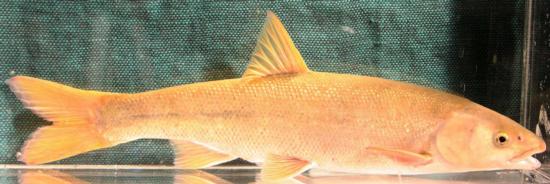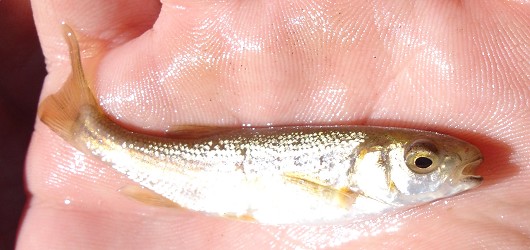Hardhead
-
Scientific NameMylopharodon conocephalus
-
NativeNative Species
-
Identification
 Hardhead, adult, right side. Location: Center for Aquatic Biology and Aquaculture, UC Davis. Date: 17 May 2007. Photo by Dave Giordano, Ecosite Media.
Hardhead, adult, right side. Location: Center for Aquatic Biology and Aquaculture, UC Davis. Date: 17 May 2007. Photo by Dave Giordano, Ecosite Media. Hardhead, adult. Photo courtesy of Dennis Cocherell, UC Davis.
Hardhead, adult. Photo courtesy of Dennis Cocherell, UC Davis. Hardhead. Location: Feather River. Date: 19 April 2010. Note the size of the mouth, which is smaller than that of a Sacramento pikeminnow. Photo by Lisa C. Thompson.
Hardhead. Location: Feather River. Date: 19 April 2010. Note the size of the mouth, which is smaller than that of a Sacramento pikeminnow. Photo by Lisa C. Thompson. Hardhead, juvenile. Photo courtesy of Dennis Cocherell, UC Davis.
Hardhead, juvenile. Photo courtesy of Dennis Cocherell, UC Davis.- Large minnows, sometimes greater than 60 cm SL, rarely exceed 30 cm in smaller streams.
- Slightly deeper bodied than Sacramento pikeminnow
- Less pointed snout than Sacramento pikeminnow
- Maxilla doesn’t extend past front margin of eye, has frenum (bridge of skin) connecting upper lip to snout (Sacramento pikeminnow lacks a frenum)
- Coloration: brown or dusky bronze back, silvery sides
- Young fish silver in color
- Breeding males may develop white tubercles along snout and laterally along body
- Fin rays: dorsal 8, anal 8-9
- Lateral line scales: 69-81
-
Life History
Hardhead are typically found in small to large streams in a low to mid-elevation environment. Hardhead may also inhabit lakes or reservoirs. All ages are omnivores though the juvenile and adult fish have a slightly different diet and tooth structure for feeding. In general these fish will eat benthic invertebrates, aquatic plants and algae, or insects. The young fish typically feed on mayfly and caddisfly larvae, as well as small snails. Older fish may focus on plants, crayfish, and larger invertebrates. In a lake environment the fish may also feed on zooplankton. Within a stream hardhead tend to prefer warmer temperatures than salmonids and they are often found associated with pikeminnows and suckers. Their preferred stream temperature might easily exceed 20ºC, though these fish do not favor low dissolved oxygen levels. Therefore the hardhead minnow is usually found in clear deep streams with a slow but present flow. Most hardhead reach sexual maturity at 3 years and spawn in the spring around April-May, though spawning may take place as late as August. In small streams hardhead tend to spawn near their resident pools, while fish in larger rivers or lakes often move up to 30-75 km to find suitable spawning grounds. Though spawning may occur in pools, runs, or riffles, the bedding area will typically be characterized by gravel and rocky substrate. Females usually produce 7,000-24,000 eggs per year, though some fisheries biologists believe that the eggs may take two years to develop within the female. Upon hatching, young larval hardhead remain under vegetative cover along stream or lake margins. As the juveniles grow they may move to deeper water or be swept downstream to larger rivers below. Adult hardhead may live up to 9 or 10 years.
-
Links to Other Research
Temperature Preference and Tolerance of Hardhead Minnows research project webpage.
Thompson, L.C., N.A. Fangue, J.J. Cech, Jr., D.E. Cocherell, and R.C. Kaufman. 2012. Juvenile and adult hardhead thermal tolerances and preferences: Temperature preference, critical thermal limits, active and resting metabolism, and blood-oxygen equilibria. Center for Aquatic Biology and Aquaculture Technical Report, University of California, Davis. Download
-
Watershed
-
Cottonwood Headwaters Watershed
-
Honcut Headwaters Watershed
-
Lower American Watershed
-
Lower Bear Watershed
-
Lower Butte
-
Lower Cache Watershed
-
Lower Calaveras-Mormon Slough Watershed
-
Lower Cosumnes-Lower Mokelumne Watershed
-
Lower Cottonwood Watershed
-
Lower Feather Watershed
-
Lower Pit Watershed
-
Lower Sacramento Watershed
-
Lower Yuba Watershed
-
McCloud Watershed
-
Middle Fork Feather Watershed
-
Middle Kern-Upper Tehachapi-Grapevine Watershed
-
Middle San Joaquin-Lower Chowchilla Watershed
-
Middle San Joaquin-Lower Merced-Lower Stanislaus Watershed
-
Mill Watershed
-
Mill-Big Chico Watershed
-
North Fork American Watershed
-
North Fork Feather Watershed
-
Russian Watershed
-
Sacramento Headwaters Watershed
-
Sacramento-Lower Cow-Lower Clear Watershed
-
Sacramento-Lower Thomes Watershed
-
Sacramento-Stone Corral Watershed
-
Sacramento-Upper Clear Watershed
-
San Francisco Bay Watershed
-
San Joaquin Delta Watershed
-
South Fork American Watershed
-
South Fork Kern Watershed
-
Suisun Bay Watershed
-
Tulare-Buena Vista Lakes Watershed
-
Upper Bear Watershed
-
Upper Butte
-
Upper Cache Watershed
-
Upper Calaveras Watershed
-
Upper Chowchilla-Upper Fresno Watershed
-
Upper Coon-Upper Auburn Watershed
-
Upper Cosumnes Watershed
-
Upper Cow-Battle Watershed
-
Upper Dry Watershed
-
Upper Elder-Upper Thomes Watershed
-
Upper Kaweah Watershed
-
Upper Kern Watershed
-
Upper King Watershed
-
Upper Merced Watershed
-
Upper Mokelumne Watershed
-
Upper Pit Watershed
-
Upper Poso Watershed
-
Upper Putah Watershed
-
Upper San Joaquin Watershed
-
Upper Stanislaus Watershed
-
Upper Stony Watershed
-
Upper Tuolumne Watershed
-
Upper Yuba Watershed
-
Please note, watersheds are at the USGS 8-digit Hydrologic Unit Code (HUC) scale, so they often include a lot of sub-watersheds. If a species occurs in any sub-watershed within the HUC, the species appears within the HUC. Link to an EPA page that shows HUCs.



